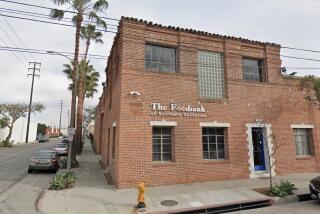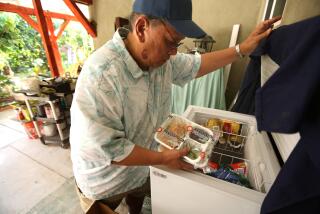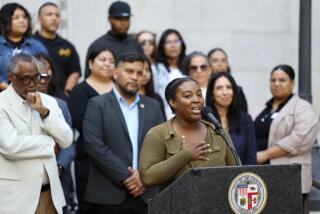Looking at poverty from the inside out
- Share via
Brian Deemer, 13, is accustomed to the good life in Manhattan Beach. This week he saw how the other half lives.
In a poverty simulation at a Salvation Army facility in downtown Los Angeles, he pretended to be a 42-year-old out-of-work college grad attempting to provide for his three children. He saw how hard it can be to put food on the table and a roof overhead when expenses vastly outweigh income -- or when there’s no income at all.
“It made me look at Los Angeles with a new perspective,” said Deemer, a seventh-grader at Rolling Hills Country Day School, a private school on the Palos Verdes Peninsula.
He and 60 other volunteer participants from businesses and nonprofit organizations gained a new appreciation for how difficult it can be for the thousands of working poor in Los Angeles to navigate the often unfriendly transportation system, social services, pawn shops and check-cashing stores that sustain them.
The problem is dire.
Los Angeles County, which has seen the loss of 170,000 manufacturing jobs in the last decade, has one of the worst poverty rates in the nation.
Almost two of five county residents, or 3.7 million people, do not have enough income to meet their basic needs, according to the Los Angeles Alliance for a New Economy, a nonprofit group that seeks to obtain money from developers for neighborhood-level and union-backed initiatives.
A report by the group, analyzing U.S. Census data, says that close to one-third of full-time workers in Los Angeles County earn less than $25,000 a year and more than 20% of children in the county live in extreme poverty.
“We hope to motivate you to become involved in breaking the cycle of poverty,” Diane Helfrey, executive director of Los Angeles Social Venture Partners, told participants. Her group sponsored the simulation along with Bank of America, the California Community Foundation and the Women’s Foundation of California.
On Tuesday, as the volunteers sat in clusters of chairs representing families, Helfrey explained how the exercise would work.
Each group had a packet containing a family profile, play money, transportation tickets and photos of cameras, TVs and other items that represented their possessions. In many cases, the family’s monthly living expenses topped their income by a significant amount.
Sitting around the edges of the room were volunteers representing bankers, the police, social service providers, grocery stores, utilities and other resources. The pawn shop turned out to be a popular stop as families cashed in items to cover rent or groceries.
Each of four 15-minute periods constituted a “week” during which participants had to buy groceries and clothing, go to work, make sure their children were in school, cash paychecks and pay utility bills. Occasionally, a family would be handed a “luck of the draw” card representing life’s little surprises, good or bad. One group won the lottery. Another learned it had a leaky water line in their home.
One family was evicted, another encountered a drug dealer and yet another had to figure out how to get a child out of protective custody. In some cases, two families helped each other so they could get by.
The aim of the simulation was to show how low-income workers can become mired in poverty, no matter how ambitious or diligent they might be.
The five adults who made up the fictional Boling family quickly learned how impossible it was to cover expenses with father Ben, 42, out of work and mother Betty making $1,324 a month after taxes as a receptionist. Each month they were more than $200 in the hole. They exhausted their $200 in savings to pay for transportation, mortgage and utilities. The family’s three “children” -- Bart, 10; Brian, 8; and Barbara, 16 and pregnant -- realized halfway through the simulation that they hadn’t actually managed to secure any food.
They found that bankers and bureaucrats in the simulation were often far from helpful. Families ended up spending a week’s worth of grocery money on check-cashing fees.
“I wanted to punch out the banker,” said Lisa Adler, a member of the Bus Riders Union. “Each week we were sinking a little. We were so desperate.”
Pamela Davis, with the California Community Foundation, portrayed a staff member of a social services agency. She said she came close to tears as she tried in vain to help a long line of applicants.
“It resonated because I’ve been on that side of the table,” she said.
“A lot of these people really want success but are focused on basic needs.”
--
More to Read
Sign up for Essential California
The most important California stories and recommendations in your inbox every morning.
You may occasionally receive promotional content from the Los Angeles Times.











